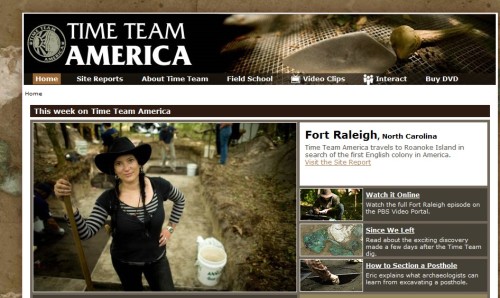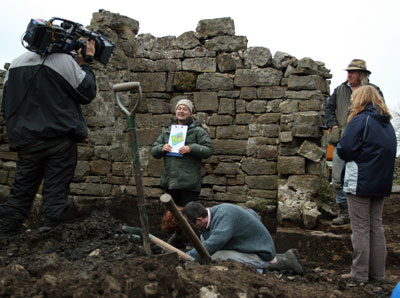Did you watch last night’s premier of Time Team America? It’s the newest show on PBS. Actually, it’s not really new. PBS borrowed the name and format from the very popular British television show – Time Team. I absolutely love the original show, so I was anxious to see the PBS version. Could it be as entertaining and informative as the original? Could they match the drama, the humor, and the science?
Time Team America follows the same general format – with a three day dig designed to resolve some particular archaeological mystery. A bunch of specialists collaborate with the excavation team. It’s fast paced. The show jumps from survey to expert to dig to artist. Ideally it all comes together in the end.
Like I said, I love the British Time Team. So I watched last night’s show with high expectations. Overall I thought Time Team America pulled it off (barely). On the plus side, the show provided a realistic depiction of archaeological fieldwork. In the first episode they were on Roanoke Island in North Carolina looking for the first English settlement in America. The excavators struggled with interpreting faint soil stains, possible postholes, that they so wanted to be part of a 16th century structure. What they found was mostly the small scraps of residue – a few ceramic sherds of European origin, a clay pipe bowl, and a glass bead. In some ways I was glad for these small finds. They really are typical of most archaeological digs – a lot of work for a little bit of old garbage.
I also liked the show’s choice of host – an artist, Collin Cambell. I think he can bring an artist’s perspective to interpretation and story-telling. Collin is young, hip, and perceptive. Unfortunately he seems to lack the playful exuberance of Tony Robinson, the host of the original Time Team. In fact, almost everyone on Time Team America came across as being a bit too serious. Probably having cameras rolling adds a lot of pressure. Hopefully the team will get more comfortable as the episodes progress. The more fun they have doing the show the more fun it will be to watch.
My wife had a minor criticism of Collin’s work. His on-the-spot pencil drawings are hard to see on tv. She thinks he should switch to charcoal drawings. It’s probably a harder medium to work with, but it would make a better visual for the viewing audience.
What I really like about both the original and the American Time Team is how well these shows illustrate the interdisciplinary nature of archaeology. Everyone plays a role. Historians, soil scientists, and geophysics specialists work with graphic artists, backhoe operators, and surveyors combine their efforts for a successful dig and more a complete interpretation. I always like to show an episode from the original Time Team to my students so that they can see the process of archaeology in action.
Next week Time Team America goes to Topper, a pre-Clovis site in South Carolina. I lecture on this site and think it is one of the most fascinating early sites in North America. I’m looking forward to this episode. Hopefully they’ll find something cool.





Time Team America
This is a post I originally made to OPB.
I think this program is quite interesting and has potential, and I have watched two of the series so far. But I have been doing archaeology in Oregon and Washington for 30 years, and most of the “Time Team America” presentation is just not reality or even close to what your publicity has suggested.
You have all these Time Team America “experts” who contribute nothing, say nothing, and do nothing. Its so obvious to anyone that has done archaeology, that all these “experts” regardless of their credentials, are planted.
Chelsea Rose, as attractive as she is, is just shown kneeling in a previously excavated Clovis floor. She contributed nothing, she said nothing, she did nothing. The same is true of your “expert” Julie Schablitsky. Her comment about the difficult field conditions during the recent Clovis series. . .”I’m hot!!” really says it all. She contributed nothing, she said nothing, she did nothing.
If you want reality, why not show and interview the people who are actually doing all the hard work No archaeology project I have ever worked on required more than the project director and perhaps a crew leader. The last thing we need are Time Team America “experts” standing around watching everyone else do the difficult work.
All of your Time Team America “experts” just ask questions of the true experts that are intimately involved in the project in question. So why pay all these “experts” that contribute so little. The artist is no different. No one has the money to pay for an artist to sit around and do speculative drawings of mammoths or historic fort palisades based on so littler evidence. For anyone in the profession who does measured drawings of things in context, the presence of your artist is ridiculous. Its not reality. The ground penetrating radar segments are rather silly as well.
None of my comments are things your general audience would particularly notice or probably care about. My suggestion is just do something like the History Detectives, where one or two people go about the business of reporting. Leave all these Time Team America “experts” at home. Same some money. They are really not contributing.
By: Robert Wenger on July 18, 2009
at 8:28 pm
Hi Robert,
It’s great to hear from someone with 30 years field experience. You have me beat by a couple of seasons!
Have you seen the British version of Time Team? You can click on the link in my post to see clips of their show online. I think you’ll gain a little appreciation for what Time Team America is trying to do.
I think it’s important for the show that they have their team of ‘experts’ and regular diggers. Eventually viewers will start to get to know the regulars and start to appreciate them as individuals. In the British Time Team, the regulars are as much a part of the show as the archaeology. They are fun to watch.
I’m actually impressed with the caliber to the Time Team America crew. How cool is it that they have Joe Watkins on their team? Or – Eric Deetz? I still assign his father’s “Small Things” book.
I also disagree with your thoughts about Colin Cambell, the show’s narrator and artist. I think it’s a great idea to include him on the team. I see his role as being like Tony Robinson on the British version. Neither Tony nor Colin are archaeologists. Their role is to be the voice for the viewer – asking questions, making observations that come from the perspective of a non-archaeologist. I do agree, however, that Colin’s drawings have been a bit underwhelming. Maybe they should give him more creative freedom. Forget the artist reconstruction and just let him be an artist. Maybe it’d be more interesting.
My last comment is in defense of ‘experts’ just standing around and not really contributing. That sounds like me. My students do the work. My teaching assistants do the supervising. I just stand around telling stories and entertaining visitors. It’s fun for me at least.
By: Brian on July 19, 2009
at 9:54 pm
Hello Brian,
I appreciate your responding because for one thing, I always regret when I get on a rant and my responses become pejorative. I do agree with your disagreements and the softer tone which you bring to the discussion. Thats very important to a show in its infancy. And if PBS is actually helping fund some archaeology who would complain.
Despite my strident tone in the original posting, it does encompass my view. Perhaps that is simply because I have spent allot of time doing field work and am always interested to see how other people go about their business. Small things like seeing people doing measured drawings and whether 1/8 or 1/4 inch screens are being used. Other archaeology folks who know their lithics for example, are also finely tuned to the subtleties.
For my interests then, I feel there is too much foreground “noise” going on by having so many personalities involved. It was quite difficult to keep track of all the Time Team members and their appearance seemed inconsistent. I don’t think Chelsea Rose has been presented as a “regular digger” or “crew leader” which PBS has suggested.
The one “real” digger PBS emphasized made his appearance in the first show and was never seen again.
No one would complain about the appearance of people like Joe Watkins or Eric Deetz. I have no problem with that. Its just that the PBS emphasis on the other celebrities and their expertise rings a little hollow when the show is actually viewed. The PBS suggestion that the team comes to a site and has a few days to solve problems is not supportable either.
Colin Cambell is a fine illustrator although my non-archaeologist sister thought he was making an archaeology coloring book for kids. In other words, his presence other than a narrator seems
way to simplistic. Sketching a whole bowl from a shard is not a reasonable example.
I also agree with you about an expert or project director that might stand around – even if just to tell stories. This especially true for university sponsored research or field schools. The director acquires an overview so they can help the folks that have their faces buried in their units get a little perspective. I have no issue with that, except that the show implies that alott of people are just hanging around telling stories. Most archaeology projects only need one. And I think the show should seriously limit the number of its actors.
By: Robert Wenger on July 20, 2009
at 10:35 am